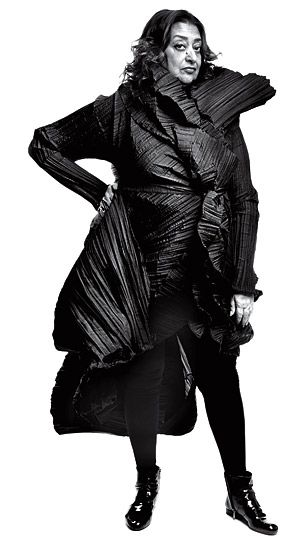
How big is your office now?
We are more than 300 people. We have projects in Michigan, Azerbaijan, Marseilles, Montpellier, China, the Olympic Aquatics Centre in London — a lot at the same time.
Your work is distinctive, but do you think it has a specific style?
There is a style, but the work didn’t come out of wanting to stylize something. It started off through figuring out what to do with lightness or flight. Later it had to do more with topography and landscape, emulating a natural form.
How does that translate to your personal style?
I like things that when you wear them, the form becomes very different from when it’s flat. I was fascinated first by Yohji Yamamoto and his asymmetry, or Comme des Garçons in the ’80s. There is a connection between architecture and fashion because of the way the body is placed within that space. I’m interested in fashion because it’s the immediate thing that shows you the temper of a particular moment.
Your Guangzhou Opera House opened last year in China. Is that a particularly sweet project since there was such a fight over your 1994 design for the Cardiff Bay Opera House?
The view from the Establishment about architecture has changed since then. The view about women has also changed. People now see the value in difference, not normative space. I remember in Berlin in 1995 when Christo wrapped the Reichstag, people flocked to it. They wanted to be part of something they were not accustomed to.
You’ve been a prominent architect for some time, but you’re only now building your first tower, in Marseilles. What took so long?
All of my work was always horizontal, so the connection between the towers and the ground was never resolved. We got this idea of the building having a skirt, maybe because I’m a woman, so I know how to wear one — who knows? — but also because it swirls at the bottom to accommodate public areas on the ground, the lobbies. You can then have a very slender tower which impacts on the horizon.
Have you ever been approached to do public housing?
No, because people make the assumption that we’re not interested and we’re expensive. But I don’t think it’s the cost; it’s the way you invent the diagrams. Luxury is not in the quality of the material but the quality of the space.
What is your favorite thing to design, after buildings?
I suppose furniture. I would have liked to design clothes, but there are so many great designers, I leave it to them.
How do you refresh yourself creatively?
I still teach occasionally. When you set up a problem for students, you have some expectation, but what is refreshing is that you’re always surprised.
What are three things anybody could do to make her home more livable?
Open it all up. If you can take the walls out — you’d have to check with an engineer — it would make it more spacious. And then you need a nice desk and a nice bed.
What is your favorite color?
Obviously black. But with different textures.
More Must-Reads From TIME
- The 100 Most Influential People of 2024
- The Revolution of Yulia Navalnaya
- 6 Compliments That Land Every Time
- What's the Deal With the Bitcoin Halving?
- If You're Dating Right Now , You're Brave: Column
- The AI That Could Heal a Divided Internet
- Fallout Is a Brilliant Model for the Future of Video Game Adaptations
- Want Weekly Recs on What to Watch, Read, and More? Sign Up for Worth Your Time
Contact us at letters@time.com